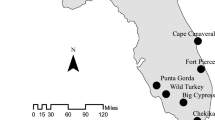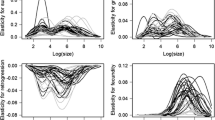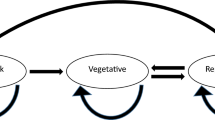Abstract
Do trade-offs between growth and reproduction differ between an invasive and noninvasive plant species and how do such trade-offs relate to population demographics? To help address these questions, we compared demographics for an invasive plant species, Rubus discolor, with a noninvasive congener, R. ursinus, in several populations of varying density. Removal of floral buds from reproductive canes increased the size of juvenile canes that arose from clonal sprouting in R. ursinus, suggesting a trade-off between current reproduction and growth. Removal of floral buds had no effect on growth of R. discolor. R. ursinus displayed trade-offs between reproduction (sexual and vegetative) and future growth based on negative correlations between leaf area production and both clonal sprouting and seedling production during the previous year. R. discolor did not exhibit these trade-offs. Both species had high population growth rates in low-density populations, but exhibited little or no growth in high-density populations. A life table response experiment was used to determine the underlying cause for the effect of density on population growth. For R. ursinus, lack of population growth in high-density populations was due primarily to increased mortality of clonally sprouting canes, while for R. discolor, it was due to decreased clonal cane production. Elasticity analysis revealed that clonal growth was more important than sexual reproduction for population growth of both species. However, elasticity values for sexual reproduction in R. discolor were greater in high- than low-density populations. This suggests an increased reliance on sexual reproduction in populations that had reached stable sizes, which could increase the capacity of R. discolor to disperse to new sites. Elasticity analyses were also used to simulate the efficacy of various control strategies for R. discolor. Control of this species could be attained by reducing clonal production within existing populations while reducing seed production to limit establishment of new populations.
Similar content being viewed by others
References
WG Abrahamson (1975) ArticleTitleReproductive strategies in dewberry Ecology 56 721–726
RL Amor (1974) ArticleTitleEcology and control of blackberry (Rubus fruticosus L. agg.) II. Reproduction Weed Research 14 231–238
TL Ashman (1992) ArticleTitleIndirect costs of seed production within and between seasons in a gynodioecious species Oecologia 92 266–272
HG Baker (1965) Characteristics and modes of origin in weeds HG Baker GL Stebbins (Eds) The Genetics of Colonizing Species Academic Press New York 147–168
S Baret E Nicolini T LeBourgeois D Strasberg (2003) ArticleTitleDevelopment patterns of the invasive bramble (Rubus alceifolius Poiret, Rosaceae) in Reunion Island: an architectural and morphometric analysis Annals of Botany 91 39–48
JP Barkham (1980) ArticleTitlePopulation dynamics of the wild daffodil (Narcissus pseudonarcissus). I. Clonal growth, seed reproduction, mortality and the effects of density Journal of Ecology 68 607–633
FA Bazzaz (1986) Life history of colonizing plants: some demographic, genetic, and physiological features HA Mooney JA Drake (Eds) Ecology of Biological Invasions of North America and Hawaii Springer-Verlag New York 96–110
AJ Bloom FS Chapin SuffixIII HA Mooney (1985) ArticleTitleResource limitation in plants–an economic approach Annual Review of Ecology and Systematics 16 363–392
DD Briske JL Butler (1989) ArticleTitleDensity-dependent regulation of ramet populations within the bunchgrass Schizachyrium scoparium: interclonal versus intraclonal interference Journal of Ecology 77 963–974
H Caswell (2000) ArticleTitleProspective and retrospective perturbation analyses and their roles in conservation biology Ecology 8 619–627
H Caswell (2001) Matrix Population Models: Construction, Analysis and Interpretation Sinauer Sunderland, Massachusetts
D Charron D Gagnon (1991) ArticleTitleThe demography of northern populations of Panax quinquefolium (American ginseng) Journal of Ecology 79 431–445
RE Cook (1985) Growth and development in clonal plant populations JBC Jackson LW Buss RE Cook (Eds) Population Biology and Evolution of Clonal Organisms Yale University Press New Haven, Connecticut 259–296
S Daar (1983) ArticleTitleUsing goats for brush control The IPM Practitioner 5 4–6
CC Daehler (1998) ArticleTitleThe taxonomic distribution of invasive angiosperm plants: ecological insights and comparison to agricultural weeds Biological Conservation 84 167–180
H Kroon Particlede A Plaisier J Groenendael Particlevan H Caswell (1986) ArticleTitleElasticity: the relative contribution of demographic parameters to populations growth rate Ecology 67 1427–1431
H Kroon Particlede J Groenendael Particlevan J Ehrlén (2000) ArticleTitleElasticites: a review of methods and model limitations Ecology 81 607–618
JF Fox GC Stevens (1991) ArticleTitleCosts of reproduction in a willow: experimental responses vs. natural variation Ecology 72 1013–1023
MA Geber (1990) ArticleTitleThe cost of mersitem limitation in Polygonum arenastrum: negative genetic correlations between fecundity and growth Evolution 44 799–819
DC Hartnett FA Bazzaz (1985) ArticleTitleThe genet and ramet population dynamics of Solidago canadensis in an abandoned field Journal of Ecology 73 407–413
Y Heslop-Harrison (1959) ArticleTitleNatural and induced rooting of the stem apex in Rubus Annals of Botany 23 307–318
M Hoshovsky (2001) Element Stewardship Abstract for Rubus discolor. The Nature Conservancy Arlington Virginia
TN Kaye KL Pendergrass K Finley JB Kauffman (2001) ArticleTitleThe effect of fire on the population viability of an endangered prairie plant Ecological Applications 11 1366–1380
PA Keddy L Twolan-Strutt IC Wisheu (1994) ArticleTitleCompetitive effect and response ranking in 20 wetland plants: are they consistent across three environments Journal of Ecology 82 635–643
DH Kent (1988) ArticleTitleRubus procerus ‘Himalayan Giant’ The Kew Magazine 5 32–35
J Kollmann DA Coomes SM White (1998) ArticleTitleConsistencies in post-dispersal seed predation of temperate fleshy-fruited species among season, years, and sites Functional Ecology 12 683–690
L Levin H Caswell T Bridges C DiBacco D Cabrera G Plaia (1996) ArticleTitleDemographic responses of estuarine polychaetes to pollutants: Life table response experiments Ecological Applications 6 1295–1313
J Maschinski R Frye S Rutman (1997) ArticleTitleDemography and population viability of an endangered plant species before and after protection from trampling Conservation Biology 11 990–999
BD Maxwell (1990) The population dynamics and growth of salmonberry (Rubus spectablilis) and thimbleberry (Rubus parviflorus). PhD Dissertation. Department of Forest Science Oregon State University Corvallis, Oregon
BD Maxwell MV Wilson SR Radosevich (1988) ArticleTitlePopulation modeling approach for evaluating leafy spurge (Euphorbia esula) development and control Weed Technology 2 132–138
BD Maxwell JC Zasada SR Radosevich (1993) ArticleTitleSimulation of salmonberry and thimbleberry population establishment and growth Canadian Journal of Forest Research 23 2194–2203
SCL McDowell (2002) ArticleTitlePhotosynthetic characteristics of invasive and noninvasive species of Rubus (Rosaceae) American Journal of Botany 89 1431–1438
SCL McDowell DP Turner (2002) ArticleTitleReproductive effort in invasive and noninvasive Rubus Oecologia 133 102–111
PB McEvoy EM Coombs (1999) ArticleTitleBiological control of plant invaders: regional patterns, field experiments, and structured population models Ecological Applications 9 387–401
AH Meyer Schmid (1999) ArticleTitleExperimental demography of rhizome populations of establishing clones of Solidago altissima Journal of Ecology 87 42–54
EA Newell (1991) ArticleTitleDirect and delayed costs of reproduction in Aesculus californica Journal of Ecology 79 365–378
AB Nicotra (1999) ArticleTitleReproductive allocation and the long-term costs of reproduction in Siparuna grandiflora, a dioecious neo-tropical shrub Journal of Ecology 87 138–149
I.M Parker (2000) ArticleTitleInvasion dynamics of Cytisus scoparius: a matrix model approach Ecological Applications 10 726–743
LF Pitelka JW Ashmun (1985) Physiology and integration of ramets in clonal plants JBC Jackson LW Buss RE Cook (Eds) Population Biology and Evolution of Clonal Organisms Yale University Press New Haven, Connecticut 399–435
EA Price C Marshall MJ Hutchings (1992) ArticleTitleStudies of growth in the clonal herb Glechoma hederacea. I. Patterns of physiological integration Journal of Ecology 80 25–38
SH Reichard CW Hamilton (1997) ArticleTitlePredicting invasions of woody plants introduced into North America Conservation Biology 11 193–203
AK Sakai FW Allendorf JS Holt DM Lodge J Molofsky S Baughman RJ Cabin JE Cohen NC Ellstrand DE McCauley P O’Neil IM Parker JN Thompson SG Weller (2001) ArticleTitleThe population biology of invasive species Annual Review of Ecology and Systematics 32 305–332
K Shea D Kelly (1998) ArticleTitleEstimating biocontrol agent impact with matrix models: Carduus nutans in New Zealand Ecological Applications 8 824–832
J Silvertown M Franco I Pisanty A Mendoza (1993) ArticleTitleComparative plant demography-relative importance of life-cycle components to the finite rate of increase in woody and herbaceous perennials Journal of Ecology 81 465–476
SC Stearns (1992) The Evolution of Life Histories Oxford University Press Oxford
JF Stuefer H Kroon Particlede J During (1996) ArticleTitleExploitation of environmental heterogeneity by spatial division of labour in a clonal plant Functional Ecology 10 328–334
J Groenendael Particlevan H Kroon Particlede S Kalisz S Tuljapurkar (1994) ArticleTitleLoop analysis: evaluating life history pathways in population projection matrices Ecology 75 2410–2415
Author information
Authors and Affiliations
Corresponding author
Rights and permissions
About this article
Cite this article
Lambrecht-McDowell, S.C., Radosevich, S.R. Population demographics and trade-offs to reproduction of an invasive and noninvasive species of Rubus. Biol Invasions 7, 281–295 (2005). https://doi.org/10.1007/s10530-004-0870-9
Received:
Accepted:
Issue Date:
DOI: https://doi.org/10.1007/s10530-004-0870-9




